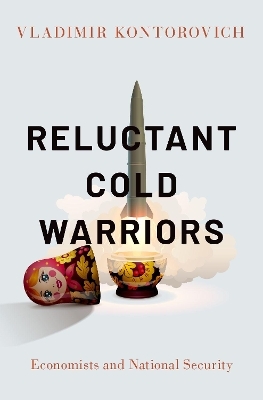
Reluctant Cold Warriors
Oxford University Press Inc (Verlag)
978-0-19-086812-3 (ISBN)
Vladimir Kontorovich shows how Western economists came up with strained non-military interpretations of several important aspects of the Soviet economy which the Soviets themselves acknowledged to have military significance. Such "civilianization" suggests that the neglect of the military sector was not forced on scholars of the Soviet economy by secrecy; it was their choice.
The explanation of this choice in Reluctant Cold Warriors raises many questions about the internal workings of economic Sovietology and its intellectual and political background. Are peripheral academic fields mimicking the agenda of the discipline's mainstream more likely to produce faulty scholarship? Did the search for the essence of socialism distract researchers from the actual Soviet economy? Were economic Sovietologists under political pressure, and if so, in what direction? This book answers these questions in a way that has broad relevance for national security uses of social science today.
Vladimir Kontorovich is Professor of Economics at Haverford College.
Table of Contents
Preface
Introduction: Why bother with the writings on a defunct economy by authors now at best retired?
PART ONE. SOVIETOLOGY AND THE SOVIET MILITARY POWER
Chapter 1. The origin and structure of Sovietology
1.1 The Cold War roots
1.2 Cradle-to-grave national security funding
1.3 The industrial organization of Sovietology
1.3.1 Structure and conduct
1.3.2 Reliability of results
1.3.3 Status within economics
1.4 Colleagues and competitors
1.4.1 The British, outsiders, political scientists, and others
1.4.2 Academics and government analysts
Chapter 2. The Politburo's Holy of Holies
2.1 A pillar of the system's original design
2.2 A wartime-size peacetime military sector
2.2.1 Official Soviet data
2.2.2 Western estimates
2.2.3 Trying to make sense of it all
2.3 The defense industry
2.3.1 A sector apart
2.3.2 The most favored sector
2.3.3 The most successful sector
2.4 Mobilization preparations
2.5 Importance and impact
PART II. SOVIET MILITARY POWER IN THE SOVIETOLOGICAL MIRROR
Chapter 3. The Missing Sector
3.1 How to document an absence
3.2 Textbooks
3.2.1 Which sectors merited a chapter
3.2.2 Applying a finer comb: index entries
3.3 Research volumes
3.4 Publications on the military sector proper
3.4.1 Journal articles
3.4.2 Books
3.5 The user side
3.5.1 Comparative economic systems textbooks
3.5.2 Introductory economics textbooks
3.6 Summary
Chapter 4. Civilianizing the objectives of the planners
4.1 Objectives and behavior in economics
4.2 Who exactly were the planners?
4.3 The Soviet account of the rulers' objectives
4.3.1 The validity of self-proclaimed objectives
4.3.2 Constitutions and planning manuals
4.3.3 Can they be believed?
4.4 The Sovietological account of planners' objectives
4.4.1 Sources: fragmentation in action
4.4.2 Sovietology's standard view
4.5 Making sense of multiple objectives
4.6 Problems with the standard view of the rulers' objectives
4.7 Patterns that seem to suggest production for its own sake
4.8 Bringing the Soviet rulers back into the fold of rational actors
Chapter 5. Civilianizing Industrialization
5.1 The standard account of industrialization
5.2 Stalin's account of industrialization
5.2.1 Objectives of industrialization
5.2.2 The role of heavy industry
5.3 How the standard account developed
5.4 Problems with the standard account
5.5 The banality of military industrialization
5.6 The real industrialization debate
5.7 Taking socialism too seriously
5.8 Summary
PART III. WHY GOVERNMENT MONEY COULD NOT BUY ECONOMISTS' LOVE
Chapter 6. The Secrecy Hypothesis
6.1 The shape of the constraint
6.1.1 Secrecy in Soviet society
6.1.2 Economic information: civilian and military sectors
6.1.3 Breaches in the wall
6.2 The constraint was not binding
6.2.1 Concern about secrecy and the recognition of gaps in knowledge
6.2.2 The use of roundabout means to overcome secrecy
6.2.3 Response to the writings on the military sector
6.3 Direct test of the secrecy hypothesis
6.3.1 Sovietologists vs the New York Times
6.3.2 What an interested scholar found in Soviet publications
6.4 Conclusion
Chapter 7. Beating Soviet Swords into Sovietological Ploughshares
7.1 The norms of the economics profession
7.1.1 How scholars choose research topics
7.1.2 How Sovietology fit in
7.1.3 Military topics out of favor with economists
7.1.4 Dressing military buildup in fashionable civvies
7.2 Looking for the essence of socialism
7.3 Politics
7.3.1 The politics and economics of science
7.3.2 Can Sovietologists inform us of each other's bias?
7.3.3 Proliferation of digressions
7.3.4 Interpretation: exculpatory incantations
7.4 Persistence of civilianization and Soviet economic history
Chapter 8. Civilianization elsewhere
8.1 Writings on German economy in the 1930s
8.1.1 Hitler's military economy
8.1.2 Rearmament in the economics journals of the time
8.1.3 Why economists neglected rearmament
8.2 (No) violence in primitive societies
8.3 The marginalization of military history
Conclusion
Appendices
Appendix 1.1 Alternative estimates of the number of Sovietologists
Appendix 3.1 How the literature was surveyed for chapter 3
Appendix 3.2 Counting index entries in books
Appendix 3.3. Books on the Soviet military sector (chronological order)
Appendix 3.4. Books on particular sectors of the Soviet economy other than external and agriculture published before 1975 (chronological order)
Appendix 3.5 Books on Soviet agriculture (chronological order)
Appendix 3.6 Books on Soviet foreign economic relations (chronological order)
Appendix 4.1 How the literature was surveyed for chapter 4
Appendix 8.1. How literature was surveyed for section 8.1
BIBLIOGRAPHY
| Erscheinungsdatum | 02.10.2019 |
|---|---|
| Verlagsort | New York |
| Sprache | englisch |
| Maße | 239 x 157 mm |
| Gewicht | 544 g |
| Themenwelt | Geschichte ► Allgemeine Geschichte ► Zeitgeschichte |
| Geisteswissenschaften ► Geschichte ► Regional- / Ländergeschichte | |
| Geschichte ► Teilgebiete der Geschichte ► Wirtschaftsgeschichte | |
| ISBN-10 | 0-19-086812-0 / 0190868120 |
| ISBN-13 | 978-0-19-086812-3 / 9780190868123 |
| Zustand | Neuware |
| Informationen gemäß Produktsicherheitsverordnung (GPSR) | |
| Haben Sie eine Frage zum Produkt? |
aus dem Bereich


